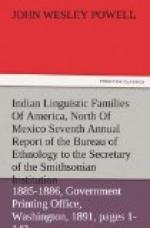The Indians of this family lived in villages, the villages as a whole apparently having no political connection, and hence there appears to have been no appellation in use among them to designate themselves as a whole people.
Dialects of this language were spoken at the Missions of San Buenaventura, Santa Barbara, Santa Inez, Purisima, and San Luis Obispo. Kindred dialects were spoken also upon the Islands of Santa Rosa and Santa Cruz, and also, probably, upon such other of the Santa Barbara Islands as formerly were permanently inhabited.
These dialects collectively form a remarkably homogeneous family, all of them, with the exception of the San Luis Obispo, being closely related and containing very many words in common. Vocabularies representing six dialects of the language are in possession of the Bureau of Ethnology.
The inland limits of this family can not be exactly defined, although a list of more than one hundred villages with their sites, obtained by Mr. Henshaw in 1884, shows that the tribes were essentially maritime and were closely confined to the coast.
Population.—In 1884 Mr. Henshaw visited the several counties formerly inhabited by the populous tribes of this family and discovered that about forty men, women, and children survived. The adults still speak their old language when conversing with each other, though on other occasions they use Spanish. The largest settlement is at San Buenaventura, where perhaps 20 individuals live near the outskirts of the town.
COAHUILTECAN FAMILY.
= Coahuilteco, Orozco y Berra, Geografia
de las Lenguas de Mexico,
map, 1864.
= Tejano o Coahuilteco, Pimentel, Cuadro
Descriptivo y Comparativo de
las Lenguas Indigenas de Mexico, II, 409,
1865. (A preliminary notice
with example from the language derived
from Garcia’s Manual, 1760.)
Derivation: From the name of the Mexican State Coahuila.
This family appears to have included numerous tribes in southwestern Texas and in Mexico. They are chiefly known through the record of the Rev. Father Bartolome Garcia (Manual para administrar, etc.), published in 1760. In the preface to the “Manual” he enumerates the tribes and sets forth some phonetic and grammatic differences between the dialects.
On page 63 of his Geografia de las Lenguas de Mexico, 1864, Orozco y Berra gives a list of the languages of Mexico and includes Coahuilteco, indicating it as the language of Coahuila, Nuevo Leon, and Tamaulipas. He does not, however, indicate its extension into Texas. It would thus seem that he intended the name as a general designation for the language of all the cognate tribes.
Upon his colored ethnographic map, also, Orozco y Berra designates the Mexican portion of the area formerly occupied by the tribes of this family Coahuilteco.[33] In his statement that the language and tribes are extinct this author was mistaken, as a few Indians still survive who speak one of the dialects of this family, and in 1886 Mr. Gatschet collected vocabularies of two tribes, the Comecrudo and Cotoname, who live on the Rio Grande, at Las Prietas, State of Tamaulipas. Of the Comecrudo some twenty-five still remain, of whom seven speak the language.




